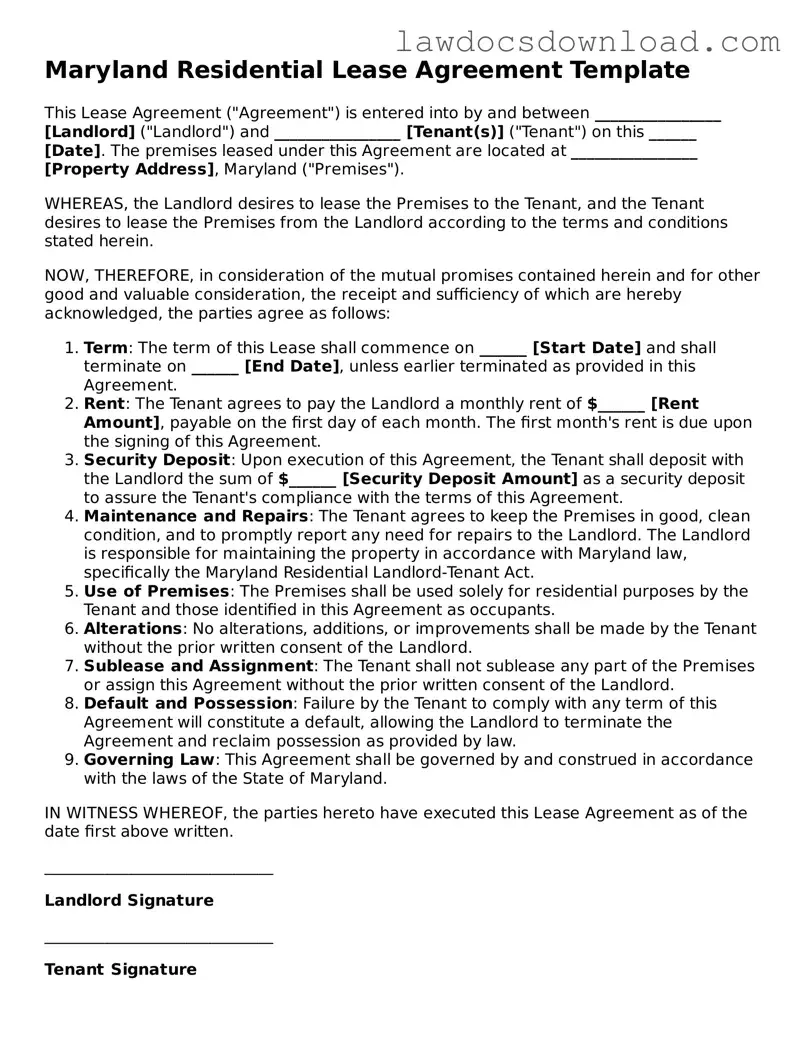The Maryland Residential Lease Agreement is similar to the Residential Lease Agreement in other states, like the California Residential Lease Agreement. Both documents outline the responsibilities and rights of both the tenant and the landlord, covering details such as rent amount, security deposit, lease duration, and policies on pets, smoking, and repairs. The major difference lies in the specific state statutes and regulations each agreement must comply with, tailoring the document to state-specific legal requirements and tenant protections.
Similarly, a Commercial Lease Agreement shares resemblances with the Maryland Residential Lease Agreement, as both establish a legally binding relationship between a landlord and tenant. However, while the former is used for residential properties, the commercial version is for business-related leases, such as offices or retail spaces. Key elements like lease term, payment schedules, and property use restrictions are present in both, although the commercial leases incorporate clauses on commercial property insurance and business taxes.
The Month-to-Month Rental Agreement is another document that reflects the structure of the Maryland Residential Lease Agreement, especially in its provision of terms regarding the tenancy. However, the key difference is the duration of tenancy and notice periods required for termination. The month-to-month agreement offers greater flexibility, allowing either party to terminate the lease typically with a 30-day notice, compared to the fixed term outlined in a standard residential lease agreement.
A Roommate Agreement, while distinct in its purpose—regulating the behavior and responsibilities of co-tenants in a shared living space—borrows elements from the Maryland Residential Lease Agreement related to rent division, utility payments, and shared space maintenance. The primary divergence lies in its focus on the interpersonal agreements between roommates, rather than the legal relationship between landlord and tenant.
The Sublease Agreement shows similarity to the Maryland Residential Lease Agreement in that it outlines the terms under which a tenant rents out the property they lease to a third party. The similarities include details on rent, security deposits, and lease duration. However, a sublease agreement requires the original tenant to act as a quasi-landlord, including the need for approval from the property owner for the sublease to be valid.
The Lease Renewal Agreement, connected closely with the residential lease agreement, serves to extend the duration of an existing lease between a landlord and tenant. It carries over most terms from the original lease, including property specifics, rent, and rules, but updates the lease term. This agreement is essential for maintaining an ongoing lease relationship without drafting an entirely new agreement.
The Land Lease Agreement, while focusing on the rental of land rather than a residential property, shares structural attributes with the Maryland Residential Lease Agreement, such as outlining the lease term, payment obligations, and rights and responsibilities of both parties. The distinction primarily lies in the Land Lease Agreement's application to agricultural or commercial use of vacant land, necessitating additional provisions about land use and maintenance.
The Eviction Notice, although not a lease agreement, is related to the Maryland Residential Lease Agreement through the enforcement aspect of lease terms. This document is a landlord's formal request for a tenant to vacate the property due to violations of the lease agreement, such as non-payment of rent or breach of lease conditions. It underscores the legal repercussions of failing to adhere to the agreed-upon terms.
The Rent-to-Own Lease Agreement merges elements found in standard residential leases with aspects of a purchase agreement, allowing tenants to rent a property with the option to buy it later. Like the Maryland Residential Lease Agreement, it includes stipulations on rent, security deposits, and lease duration. However, it also introduces terms related to the purchase option, including price and time frame, distinguishing it from purely rental agreements.
Lastly, the Property Management Agreement stands as a parallel document to the Maryland Residential Lease Agreement, outlining the relationship between a property owner and a property manager, who acts on the owner's behalf in managing the rental property. It encompasses many of the operational duties found in a lease agreement, such as maintenance, rent collection, and tenant screening, but from the perspective of property management rather than direct landlord-tenant interaction.
